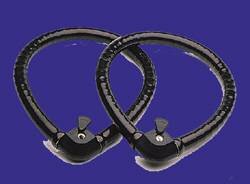There are many hundred of cycle locks available that include, shackle, cable, “electronic”. Some with tumbler locks, others with padlocks, keys or batteries. Some are as much use as a “kick in the ‘ead”, or a chocolate teapot, but many make it increasingly difficult for the opportunist thief to whisk your bike away.
Whatever type of lock you choose, please buy the highest quality lock you can afford. Don’t skimp, like cycle helmets, you get what you pay for and the attitude “I’ll buy the cheapest” usually leads to that sinking feeling mentioned elsewhere.
Background information regarding cycle locks
A good lock must resist two types of attack – brute force like bolt/cable cutters and sophisticated attack including lock picking.
U-Shackle locks
There are some important features which any U-shackle lock should have if it is to provide the best possible security for your bike and its components.
They are:
-
Specially toughened steel giving a hard surface to resist cutting
-
A lock mechanism mounted in the centre of the “crossbar”, offering the most protection from attack
-
No part of the lock should protrude; this would make the lock vulnerable to attack 
-
A “crossbar” which locks onto both ends of the shackle, to resist levering.
-
A symmetrical shackle that can be locked either way round, to make the lock easier to use.
Cable locks
The thicker the cable, the better the protection. Buy the thickest you can afford. Increasing numbers of cable locks are now fitted with rollers over the cable. This makes it very difficult for cable cutters to be cut through, as they can’t grip onto the cable.
|